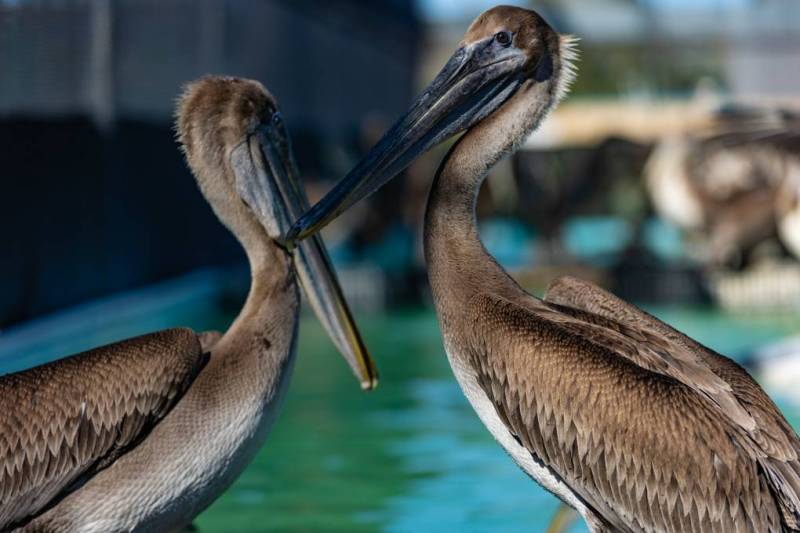Rebecca Duerr, who directs veterinary science at International Bird Rescue, said this spring, a toxic algal bloom first poisoned some adult birds. The blooms, predicted to become more severe with climate change, have lasted longer this year.
And then came the starving babies. The majority of the roughly 250 pelicans International Bird Rescue received since March were less than 6 months old. The center gets about two-thirds of the birds statewide and considers 90 birds a month highly unusual.
This second wave of almost 200 rescued starving babies is still a mystery. Maybe the algal blooms also affected them. Maybe their successful breeding season just meant higher numbers didn’t learn to forage. Another theory about these starving young, Duerr said, is that their parents, sickened by the harmful algal blooms, might have abandoned them before they were ready to forage alone.
“These young birds didn’t know how to eat yet,” Duerr said. “It’s circumstantial evidence, but it looked like, you know, if mom doesn’t come back, they have to leave the nest or they’ll die.
So far, there are less starving pelicans than last year. And, luckily, the numbers show the starvation event slowing down.
While Overdose Deaths Drop Nationwide, California’s Numbers Climb
More than 11,000 people died of a drug overdose in California in 2023, which is about 400 more people than the prior year.
Dr. J. Nadine Gracia leads Trust for America’s Health, a nonpartisan group that tracks overdose and suicide trends. She said the western part of the U.S. is seeing some of the sharpest increases — and California’s crisis is being fueled by fentanyl and rising use of stimulants like meth.
“What we need to do is bolster our programs that support addressing adverse childhood experiences and trauma,” Gracia said. “And really invest in resilience, mental health, and substance use.”
Deaths from alcohol and suicide are falling in California. But Gracia warned that progress is fragile — especially as overdoses continue to rise.
Under scrutiny from state and federal lawmakers, California’s community colleges are trying to crack down on financial aid fraud. Scammers have increasingly infiltrated the state’s 116 community colleges, posing as students in an effort to steal financial aid from the state and federal government.
At a meeting recently, the board that oversees California’s community colleges voted to require all students to verify their identity, which is currently optional for most applicants. The board also considered asking the Legislature for approval to charge students a nominal application fee — which many said should be no more than $10. But after more than two hours of debate, the board rejected that proposal and instead asked staff to “explore” a fee policy.
Students from across the state told board members that they were against imposing a fee, sharing stories of times when they were so poor that they didn’t have a bank account or $10 to buy lunch. Many had personal experiences with fake students.
Flo Cudal, a student at Santiago Canyon College in Orange County, testified about her own experience with scammers.
“A bot once took my seat in a class I needed to graduate and transfer,” Cudal said. “That fraud almost cost me my future. I understand the need for strong protections, but they must not come at the expense of excluding a real student.”
Even though students have to sign an affidavit swearing that their personal information is valid when they apply, only a few schools require applicants to upload an ID to prove their identity. The board vote means prospective students would be required to submit IDs with their applications.

